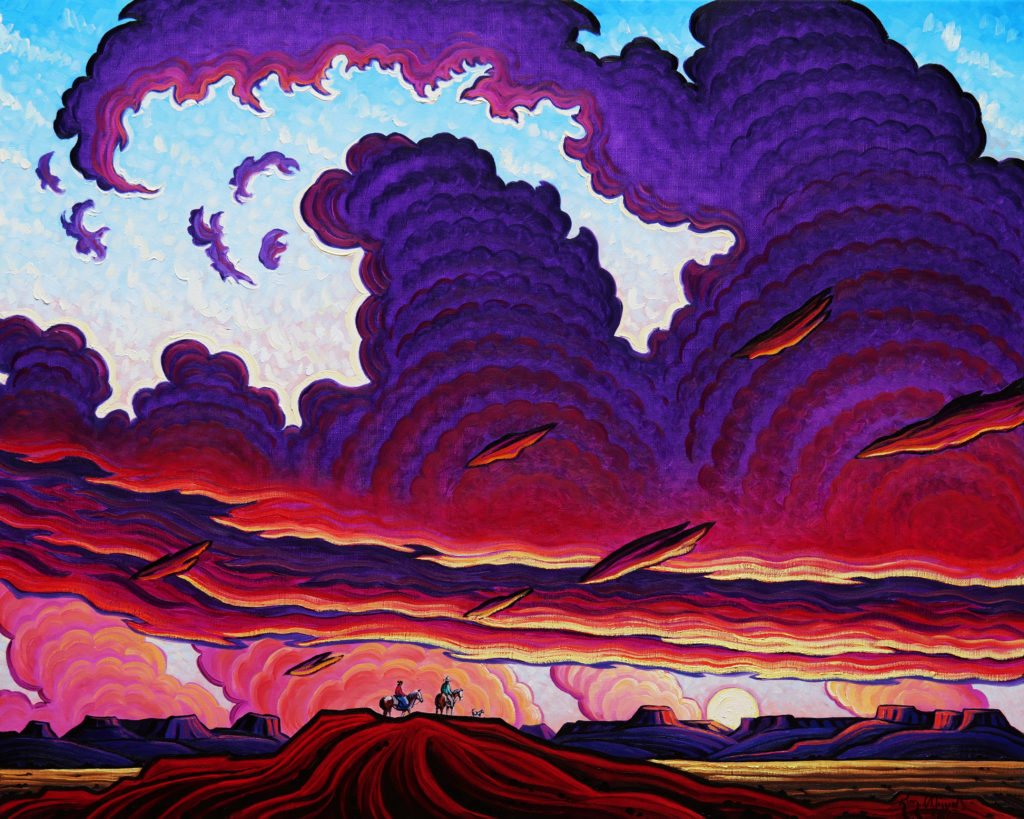
In the studio with New Mexico modernist Kim Wiggins.
Written by Jenn Thornton
For his upcoming solo show The Unexpected West, set for Nov. 9th, 2024, at Legacy Gallery in Scottsdale, Arizona, Kim Wiggins—a prolific painter of the American West—has completed a range of compelling new works. Of these, the eight-foot “Chisolm Trail” is particularly ambitious, depicting a massive stampede on the arduous journey from South Texas to Abilene, Kansas. Coincidentally, the route also inspired the John Wayne classic Red River and is one that Wiggins understands both historically and intimately as a true son of the Southwest.
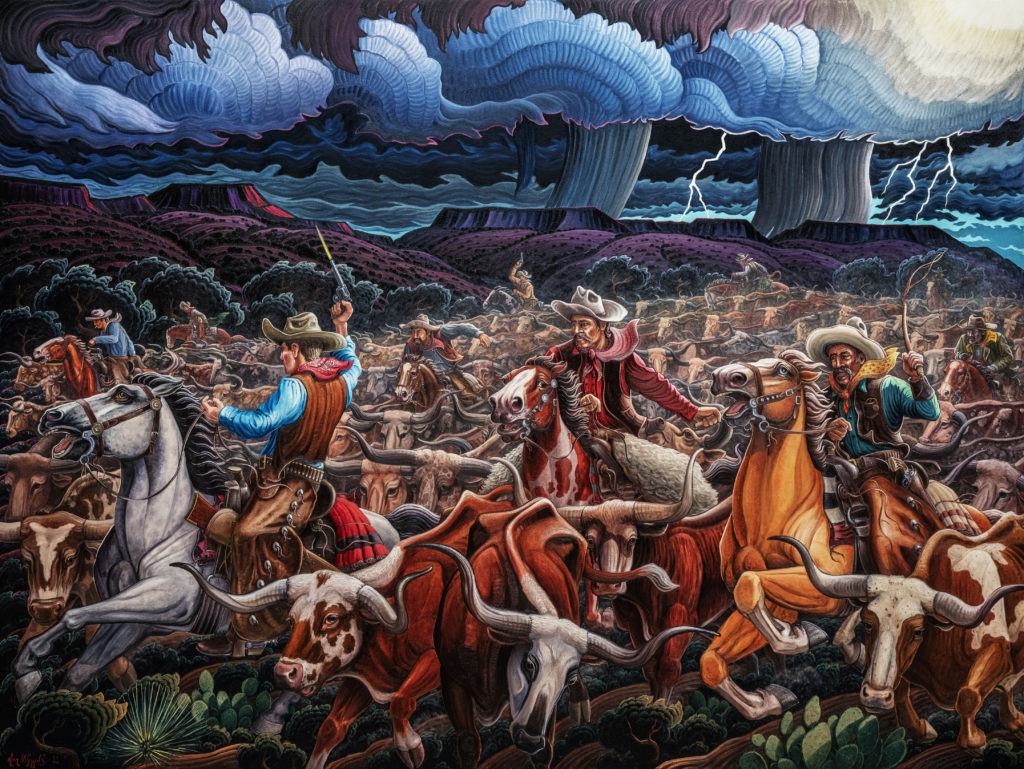
Raised in a ranch bordering the Pecos River in Southeastern New Mexico, Wiggins regional roots are sturdy and enduring. His is a ranching family of rich artistic inclination and gifted storytellers. Not least Wiggins himself. “Telling stories is what I do—I just use oil instead of a pen,” affirms the artist, whose grandfathers were storytellers, too. His grandmother, meanwhile, was a photographer and a painter, and his uncle another artist who painted to little acclaim but with significant joy. Wiggins’ parents were enthusiastic art patrons: his mother was a friend of modernist maven Georgia O’Keeffe and later worked as an art conservator, and his father, a photojournalist for the likes of Life and Sports Illustrated, produced all sorts of swashbuckling adventure stories, from capturing condors in the Andes to chasing down jaguars in the Amazon.
In this milieu, Wiggins sold his first piece of art, a work of sculpture, at age 12. It was one of many pieces that a Scottsdale art dealer named Jim Clark discovered on a mantle at his family home—and with it, a promising young talent whose work he would subsequently market throughout Wiggins’ high school years. The partnership proved both pivotal and longstanding. Following a five-year stint in the military that saw Wiggins serve in both Europe and San Antonio, Texas to fund his education, the artist returned to New Mexico where, once again, he crossed paths with Clark. After a call, the pair agreed to meet at the plaza in Santa Fe where Wiggins presented his patron with 10 paintings; Clark took seven back to Scottsdale and sold one the next day.
Wiggins started painting more seriously at that point, but as a father of two, he was not entirely confident in cashing in all his chips for an unknown career as a professional artist—certainly not when he had enough resources to pay his bills and nothing more. Setting aside pragmatism for possibility was a gamble. But worth it, Wiggins reasoned, were he to produce several paintings in a month with the hope of selling even one at a rate that would allow him to continue. “I painted like a madman,” remembers Wiggins, whose marathon effort resulted in cache of smaller works. “I loaded them all into my vehicle, headed for Lubbock and started knocking doors.” But few folks were interested in what Wiggins was selling: not his paintings, nor his pitch. Doors slammed shut. Morning turned to afternoon. The heat was rising in all kinds of ways. Finally, an older woman took pity on the unknown artist from neighboring New Mexico. “I don’t know what I looked like by that time,” Wiggins confesses, “but she said, ‘Young man, you look like you need a glass of iced tea. Bring in a few of your paintings and I’ll take a look.’” She liked what she saw, sending Wiggins on his way with a check for $500—and, more importantly, the confidence to become a professional artist.
Perhaps even an artist of the caliber that his parents would call up out of the blue, depending on where they happened to be, and arrange a get-together. In Missouri, Wiggins watched painter Thomas Hart Benton go through his sketchbook. In New Mexico, he had lunch with Georgia O’Keeffe at her home Ghost Ranch. Among his mentors were Henriette Wyeth and, most crucially, Oklahoma artist Alexandre Hogue, who taught Wiggins how to look beyond the paint to the power behind the image. “An image so powerful that it speaks to your heart and changes your life,” Wiggins says. “A work of art you always remember.” The type of work he now creates.
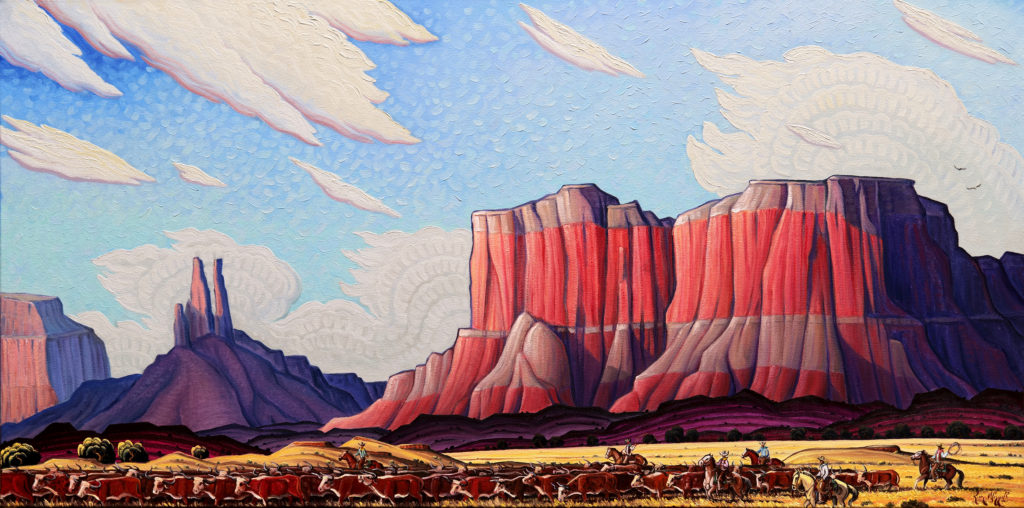
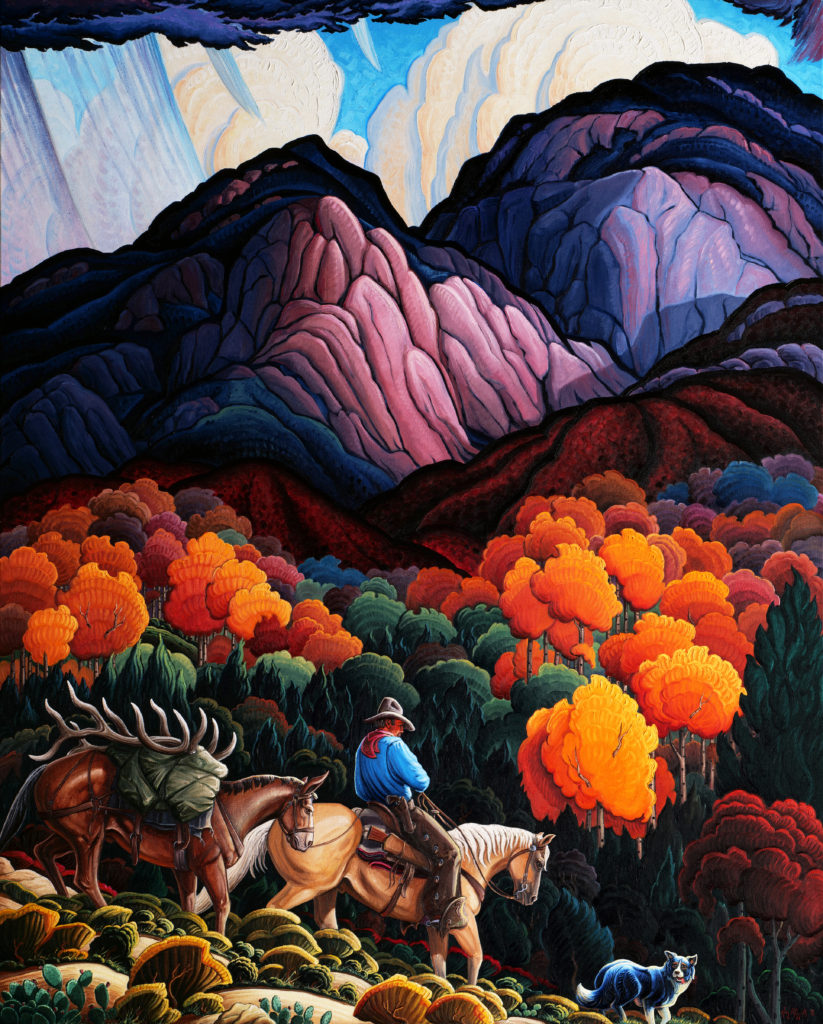
Wiggins defining feature as an artist is that his work is in fact undefinable. Distinct, yet undefined. There are recognizable influences, but he does not adhere to a single style. His repertoire is wide. “I’m a modernist, that’s all I can say,” he says. “I paint expressionistic work, but I’m not an expressionist. I’m not a magical realist either. I don’t fit comfortably in any box.”
“I paint expressionistic work, but I’m not an expressionist. I’m not a magical realist either. I don’t fit comfortably in any box.”
Of all the things Wiggins is—among them heavily accoladed (he was the youngest member of the Society of American Impressionists at his induction in 1983, and has received multiple honors, from the 2014 New Mexico Historical Society’s Heritage Award and the 2020 Gold Medal for Best Narrative at the Autry Museum to the NAACP commission to document various aspects of Black history)—Wiggins is best known as a founder of the current New West Movement. It is not a role he has simply adopted; it’s not a branding exercise. Wiggins’ connection to the West is authentic and fundamental to his work.
“I am one of the few Western artists today that has the heritage that I’m painting—a family history that I can share,” Wiggins relays. “I know what it’s like to ride a horse, to work cattle, to brand, to worry about calving. The essence of this is already within me.” So too is the regionalist sensibility that birthed the New Mexico modernism still rife in the artistic Edens of Taos and Santa Fe. For Wiggins, encapsulating the West artistically is what will help identify America as a people and a culture—its diversity, its vibrance, its striving. “The soul of a society that is the artist’s job,” he says. “That’s why I focus on the West as an artist. I love the West. It’s who I am.”
One sees this tie in The Unexpected West, a show that, like Wiggins himself, contains multitudes. Along with the “Chisolm Trail” is an array of works depicting everything from a Midwest tornado to a bayou scene of a beautiful Black spiritualist. “I wanted the show to have a wide span, and to speak to a variety of people. I didn’t want people to think, ‘That is just another cowboy painting.’ I want them to feel like they have had an experience in the West.”
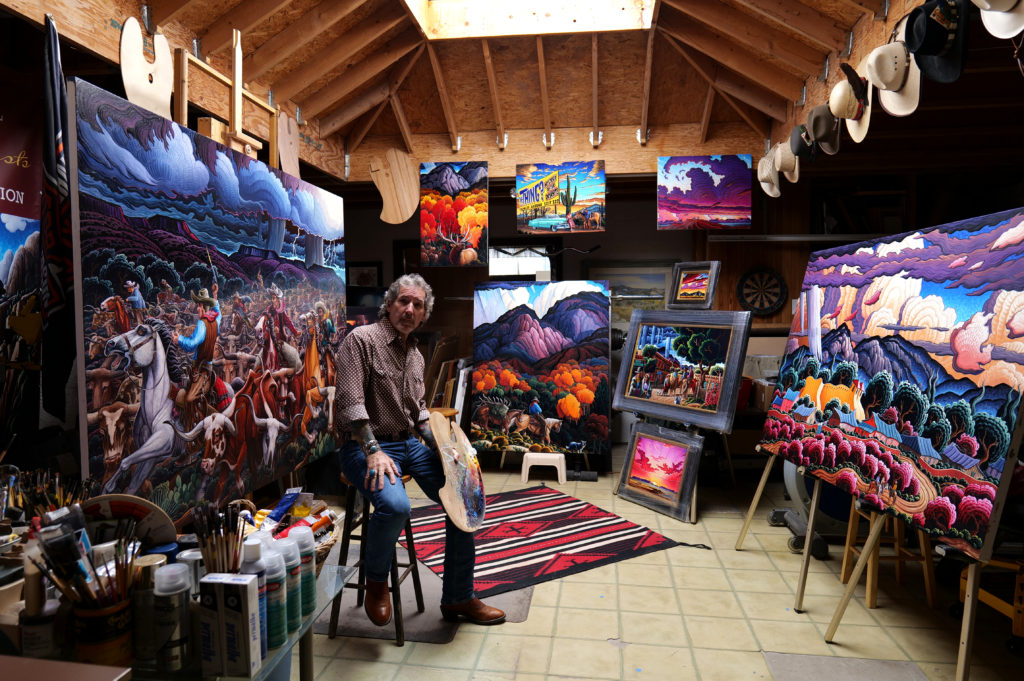
Photographs courtesy of Kim Wiggins


